Tibetan antelope
(Pantholops hodgsonii)

Description
The Tibetan antelope or chiru (Pantholops hodgsonii) is a medium-sized bovid native to the northeastern Tibetan plateau. Most of the population live within the Chinese border, while some scatter across India and Bhutan. Fewer than 150,000 mature individuals are left in the wild, but the population is currently thought to be increasing. In 1980s and 1990s, they had become endangered due to massive illegal poaching. They are hunted for their extremely soft, light and warm underfur which is usually obtained after death. This underfur, known as shahtoosh (a Persian word meaning "king of fine wools"), is used to weave luxury shawls. Shahtoosh shawls were traditionally given as wedding gifts in India and it takes the underfur of three to five adult antelopes to make one shawl. Despite strict controls on trade of shahtoosh products and CITES listing, there is still demand for these luxury items. Within India, shawls are worth $1,000-$5,000; internationally the price can reach as high as $20,000. In 1997 the Chinese government established the Hoh Xil National Nature Reserve (also known as Kekexili) solely to protect the Tibetan antelope population. The Tibetan antelope is a medium-sized antelope, with a shoulder height of about 83 cm (32+1⁄2 in) in males, and 74 cm (29 in) in females. Males are significantly larger than females, weighing about 39 kg (86 lb), compared with 26 kg (57 lb), and can also be readily distinguished by the presence of horns and by black stripes on the legs, both of which the females lack. The coat is pale fawn to reddish-brown, with a whitish belly, and is particularly thick and woolly. The face is almost black in colour, with prominent nasal swellings that have a paler colour in males. In general, the colouration of males becomes more intense during the annual rut, with the coat becoming much paler, almost white, contrasting with the darker patterns on the face and legs. The males have long, curved-back horns that typically measure 54 to 60 cm (21 to 24 in) in length. The horns are slender, with ring-like ridges on their lower portions and smooth, pointed, tips. Although the horns are relatively uniform in length, there is some variation in their exact shape, so the distance between the tips can be quite variable, ranging from 19 to 46 cm (7+1⁄2 to 18 in). Unlike caprines, the horns do not grow throughout life. The ears are short and pointed, and the tail is also relatively short, at around 13 cm (5 in) in length.
Taxonomic tree:







